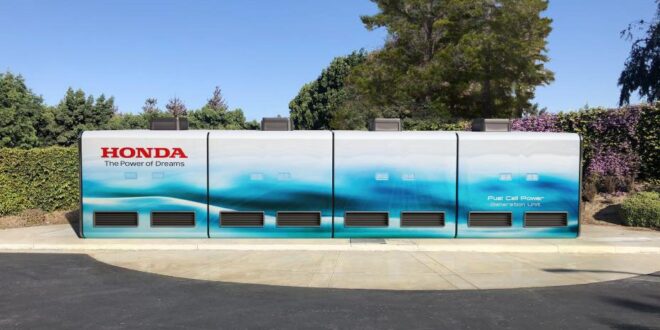Honda Motor aims to supply fuel cells to big tech companies in North America as clean emergency power for data centers, in a bid to harness the growth driven by artificial intelligence to bring down costs for hydrogen-powered vehicles.
A trial of the backup system is underway at a Honda facility located a half-hour drive southeast of Los Angeles International Airport, where a unit can be seen letting off steam as it powers a small data center.
Fuel cells combine hydrogen with oxygen from the atmosphere to generate electricity, emitting only water as byproduct. Development of the technology has been ramping up amid the global push to cut greenhouse gas emissions.
“We’re targeting demand for alternatives to fossil-fuel-powered generators,” said Takashi Ogi, the head of Honda’s energy business in North America, adding that “we can contribute to carbon neutrality.”
Honda has linked eight of its automotive fuel cell systems in the backup generator, for a total output of 500 kilowatts. It is running tests covering dozens of points, including ensuring it can start running immediately and maintain normal output if the data center loses its regular power supply.
The automaker plans to begin sales as early as 2025, after the rollout this year of a new fuel cell vehicle for the U.S. market.
Honda is testing the technology in the U.S. because it is home to big tech companies that run numerous data centers. Amazon.com — the world’s largest provider of cloud services — aims to go carbon neutral by 2040, and Microsoft by 2030.
Demand for data centers is soaring, driven partly to the rise of generative artificial intelligence. The International Energy Agency estimates that global power consumption by data centers could reach 1,050 terawatt-hours in 2026, more than double the 2022 figure.
Data centers are crucial in a world that relies on digital services. “If they stop working, that means a shutdown of social infrastructure,” a Honda representative said.
These facilities are equipped with backup generators in case of outages from accidents or natural disasters, letting them continue to run for two or three days until utility power is restored. These are typically fueled by diesel, with output in the thousands of kilowatts and prices in the hundreds of thousands of dollars. They are easy to use and cost-effective, but emit greenhouse gases.
The Energy Futures Initiative, a U.S. nonprofit, has said that fuel cells can provide “quick and reliable backup power on demand, which would run much cleaner than diesel generators.” It sees them being commercialized for this purpose between 2025 and 2035.
Honda has been developing fuel cells through a joint venture with General Motors in Michigan. The venture began mass production last month of a new system that is twice as durable as previous versions and performs better in low temperatures, a weakness of the technology.
Honda released its first fuel cell vehicle in 2002. The automaker aims to sell only electric and fuel cell vehicles by 2040.
But the high price of fuel cell cars, along with a lack of fueling infrastructure, have held them back. Fewer than 80,000 were on the road worldwide in 2022, IEA data shows — a far cry from the 10 million EVs sold worldwide in a year.
To lower production costs, Honda and GM have worked together on procuring materials and cutting down on the amount of precious metals used. The new module costs a third as much to make as the fuel cells in Honda’s 2019 Clarity.
By marketing the technology for use in data centers, Honda hopes to improve economies of scale. It aims to cut manufacturing costs in half again by 2030 while doubling durability.
“Our goal is a fuel cell system that rivals diesel engines on convenience and cost,” said Tetsuya Hasebe, head of Honda’s hydrogen business development division.
The automaker looks to turn out 60,000 cells annually by 2030, including both vehicles and power systems, with sales outside North America slated to start in the late 2030s.
The U.S. government has announced aid for clean hydrogen production.

 Iran Energy News Oil, Gas, Petrochemical and Energy Field Specialized Channel
Iran Energy News Oil, Gas, Petrochemical and Energy Field Specialized Channel



